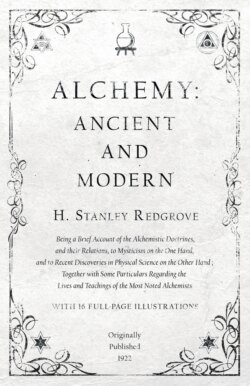Читать книгу Alchemy: Ancient and Modern - Being a Brief Account of the Alchemistic Doctrines, and their Relations, to Mysticism on the One Hand, and to Recent Discoveries in Physical Science on the Other Hand - H. Stanley Redgrove - Страница 13
На сайте Литреса книга снята с продажи.
Alchemistic Language.
Оглавление§ 5. In the second place, we must notice the nature of alchemistic language. As we have hinted above, and as is at once apparent on opening any alchemistic book, the language of Alchemy is very highly mystical, and there is much that is perfectly unintelligible in a physical sense. Indeed, the alchemists habitually apologise for their vagueness on the plea that such mighty secrets may not be made more fully manifest. It is true, of course, that in the days of Alchemy’s degeneracy a good deal of pseudo-mystical nonsense was written by the many impostors then abounding, but the mystical style of language is by no means confined to the later alchemistic writings. It is also true that the alchemists, no doubt, desired to shield their secrets from vulgar and profane eyes, and hence would necessarily adopt a symbolic language. But it is past belief that the language of the alchemist was due to some arbitrary plan; whatever it is to us, it was very real to him. Moreover, this argument cuts both ways, for those, also, who take a transcendental view of Alchemy regard its language as symbolical, although after a different manner. It is also, to say the least, curious, as Mr. A. E. Waite points out, that this mystical element should be found in the writings of the earlier alchemists, whose manuscripts were not written for publication, and therefore ran no risk of informing the vulgar of the precious secrets of Alchemy. On the other hand, the transcendental method of translation does often succeed in making sense out of what is otherwise unintelligible in the writings of the alchemists. The above-mentioned writer remarks on this point: “Without in any way pretending to assert that this hypothesis reduces the literary chaos of the philosophers into a regular order, it may be affirmed that it materially elucidates their writings, and that it is wonderful how contradictions, absurdities, and difficulties seem to dissolve wherever it is applied.”5
The alchemists’ love of symbolism is also conspicuously displayed in the curious designs with which certain of their books are embellished. We are not here referring to the illustrations of actual apparatus employed in carrying out the various operations of physical Alchemy, which are not infrequently found in the works of those alchemists who at the same time were practical chemists (Glauber, for example), but to pictures whose meaning plainly lies not upon the surface and whose import is clearly symbolical, whether their symbolism has reference to physical or to spiritual processes. Examples of such symbolic illustrations, many of which are highly fantastic, will be found in plates 2, 3, and 4. We shall refer to them again in the course of the present and following chapters.
